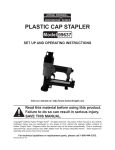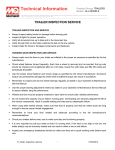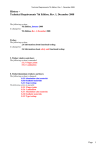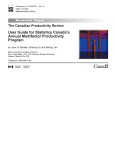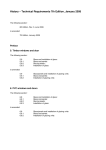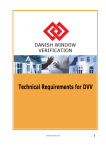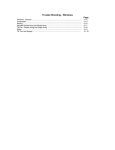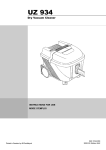Download Installer and User Manual
Transcript
Installer and User Manual FOR DVV-LABELLED WINDOWS AND EXTERNAL DOORS IN ALUMINIUM CONTENTS The safe choice...................................................... VinduesIndustrien................................................... Delivery and storage.............................................. Installation, fixing and sealing................................ Performance and operation.................................... Top hung casement................................................ Top guided casement............................................. Top reversible casement........................................ 2 Side hung casement.............................................. Tilt/turn casement................................................... Side swing and side guided casements................. External doors........................................................ Patio doors............................................................. Tilt/turn doors.......................................................... Lift/slide doors........................................................ Tilt/slide doors........................................................ Maintenance, cleaning and lubrication................... Ventilation of the dwelling....................................... DVV Warranty......................................................... DVV-labelled units.................................................. 3 4 4 5 8 9 9 10 10 11 11 12 12 13 13 13 14 15 17 19 THE SAFE choice Congratulations on choosing DVV-labelled windows and external doors from a member of VinduesIndustrien, the Association of Danish Window Manufacturers. Buying these DVV-labelled units from one of our members ensures that your windows and external doors have been manufactured under quality control. However, to ensure satisfactory performance in the short and long term it is important that the units are installed and maintained in accordance with the instructions. Correct installation and maintenance is important Follow the instructions in this leaflet. If you are not sure how to install the units, please contact the window manufacturer who will provide the necessary instructions. Otherwise, incorrect installation may cause the units to malfunction. This type of problem is not covered by the window and door warranty. Following this manual and having the units installed by experienced window and external door installers is the best safeguard and also ensures the performance of the units. With regular maintenance and correct treatment in accordance with this manual your new quality products will continue to provide pleasure for years to come. Kongsvang Allé 37 · Bygning 16 · DK-8000 Århus C Tel. (+45) 7220 1822 [email protected] · www.vinduesindustrien.dk 3 VinduesIndustrien Founded in 1977, VinduesIndustrien is an industry association comprising some 65 Danish manufacturers of windows and external doors. units, which form the basis for the quality control conducted one or twice annually in the companies by an imppartial body. The general purpose of VinduesIndustrien is to look after the common interests of the industry. In this context, safeguarding consumers when they buy windows and external doors takes high priority. Regularly updated, the Technical Requirements provide the optimum basis for the manufacture of windows and external doors. This applies in particular to their function and life with ever increasing attention to energy and environmental aspects. For more information, please go to www.vinduesindustrien.dk Another important task for VinduesIndustrien is to draw up and maintain the Technical Requirements for DVV-labelled 4 DELIVERY and storage During unloading and subsequent handling of the units you must employ lifting gear and methods which do not cause damage to the units. The buyer must check incoming goods on arrival to ensure that the delivery meets the contract and that there are no obvious defects or damage to the units (e.g. caused in transport).If there are grounds for complaints or queries, the supplier must be notified without delay. Labels and cork pads on glazing units must be removed no later than two weeks after receipt of the goods. All corner protectors, protective foil or other protective packaging must remain in place and only be removed when the units are fitted. If stored outdoors, the units must be placed on bearers or pallets to provide sufficient clearance from the ground. The units must be securely covered to protect them from precipitation and dirt. At the same time, proper ventilation around the units must be ensured to limit the risk of condensation under the cover. Separate glazing units should be stored under a roof. INSTALLATION fixing and sealing General Correct installation is crucial for the functioning and life of the units. Therefore, the work should be performed by workmen skilled in the installation of windows and external doors. The following instructions cover some of the main aspects of the installation work but not all the details which may play a role in the installation. Normally, windows and doors are supplied with the glazing units fitted but in the case of fixed lights, glazing units are often fitted after the frames have been installed. Such glazing units must be fitted in accordance with The Technical Requirements for DVV. It will facilitate the installation of most types of unit to remove the casement or door leaf before the first stage of the installation of the frame. Installation The frame is normally positioned in the wall hole with a uniform gap around jamb and head while taking account of the level of the frame sill in relation to the wall sill/floor level. The gap between the frame and the surrounding brickwork/ wall structure should normally be around 12 mm. The recommendation is to set the window/door unit back 4 to 5 cm from the external face of the wall to offer some protection against the weather. At the hinge side, the frame must be level and plumb (wide and narrow side). The frame must be adjusted and fixed to allow the correct fit and prescribed clearance all the way round between frame and casement. Fixing Windows and external doors must always be fixed to the surrounding brickwork or building structure by means of mechanical fasteners such as frame screws/dowels or brackets. Common to the fixing methods to choose between is that - irrespective of method - they must be capable of transferring all horizontal and vertical forces caused by outside impacts and the weight of the construction itself. If fixing to the face wall is chosen, windows and outer doors must be fixed mechanically to the adjoining building parts using e.g. frame screws/dowels or fasterners. If fixing to inner wall prior to brick facing is preferred, purpose-made fasteners are required. Subsequent fixing to the wall is necessary and before fixing, 5 the casement must be adjusted to achieve a correct strike and the prescribed air flow between casement and frame. When using expanding foam to fill the gap between the external face of the frame and the surrounding brickwork or building structure, you must apply the same mechanical fixing method as described below. If the frame is secured by fasteners (frame screws and dowels or brackets) at each individual fixing point in the opening, the unit will not need permanent blocks. 6 ill. 1 Fasteners such as frame screws and dowels are normally located in the frame rebate, cf. ill. 2. ill. 2 Other fasteners require the use of firm, permanent blocks of a material which remains stable under moisture, such as marine plywood or a synthetic material, possibly with the addition of a damp proof course. Permanent blocking must not be used at the head of wide units, e.g. lift-and-slide doors, where there is a risk of exposure to load from the structure above. In general, the distance between fixing points must not exceed 90 cm, cf. ill. 1. Special instructions - windows If units are less than 120 cm wide, no fixing at head and sill is required. Permanent blocks must be inserted under the extremes of sills at both ends; units with mullions also require permanent blocks under the sills below the mullions, cf. ill. 3. The blocking material must meet the requirements stated for permanent blocks/damp proof courses. ill. 3 located close to the respective hinges. Permanent blocks must be inserted under the extremes of sills at both ends; wide doors must be permanently blocked below the centre of the sill, cf. ill. 4. Double leaf doors with or without a centre post must be permanently blocked under the post/where the leaves abut. The blocking material must meet the requirements stated for permanent blocks/damp proof courses. ill. 4 Special instructions - doors At the hinge side, the upper and lower fastener are Application of sealant The application of sealant (caulking) should follow the guidelines for the project in hand or the guidelines drawn up by Fugebranchens Samarbejds- og Oplysningsråd/ FSO, the cooperation and information council of the Danish sealant application and manufacturing industry. www.fugebranchen.dk When caulking, care must be taken not to compress the The frame must be permanently blocked behind the strike plate at the closing side, cf. ill. 4. This block serves primarily to make the door intrusion resistant. material so hard that it causes distortion of the frame section. If using expanding foam to fill the gap between frame and wall structure, the frame must be stiffened until the foam has expanded fully or the frame sections kept straight in some other way. Externally, there must always be a protective finishing coat in the form of a mastic sealant, tape or a similarly effective measure. 7 PERFORMANCE and operation Friction brake Frame Casement Espagnolette bolt Strike plate Glazing bead Sealant tape 8 Handle Glazing unit Hinge side Hinge Casement weather seal Closing side TOP HUNG casement Various types of hinges are used for top hung casements, all of them providing a fixed pivoting point near the casement head. Opening the window projects the lower part of the casement outwards, while the casement head basically stays in position apart from pivoting round the hinge. The casement is usually operated via a handle located in the middle of the bottom rail. The casement can be retained in a ventilation position giving a 1-2 cm gap at the bottom. The window may have a casement stay to hold the casement in position when opened to a wider angle. As a design, the top hung casement has to a considerable extent been replaced by the top guided casement, cf. below. TOP GUIDED casement 9 The casement is operated by a handle located in the middle of the bottom rail. When opened, the casement can be retained in a ventilation position giving a 1-2 cm gap at the bottom. This type of casement features top guided hinges in the upper frame and casement jambs; opening the window projects the lower part of the casement outwards and pulls the casement head down a little in the process. When opened to a wider angle, the casement is controlled by friction brakes in the hinges. The amount of friction can be easily adjusted, but you must ensure that the amount of friction applied is the same at both sides of the casement. Please note that the friction brake will not retain the casement in position under higher wind loads. side hung casement The type of hinge may vary but ordinary side hung casements function the same way. Older (mullion/transom) window designs normally use (short) casement fasteners with a longer sturdier type of fastener for 90° opening angles. More recent designs are operated by means of a single handle at the closing side of the casement; while in the open position the casement may be guided by a friction brake. Please note that the friction brake will not retain the casement in position under higher wind loads. tilt/turn casement 10 A tilt/turn casement is an inward opening window which, as the name implies, will turn perpendicularly on hinges in the casement jamb and tilt horizontally from hinges in the bottom rail/ sill. The side hung function is primarily used in connection with cleaning of the external face of the glazing unit, while the bot- tom rail pivoting function is used to provide ventilation. The casement is operated by a handle in the casement jamb; when closed, the handle is turned downwards. Depending on the make of handle, one function is achieved by turning the handle to a horizontal position and the other position by turning it (upwards) to a vertical position. By turning the handle to 45° it will often be possible to secure the casement in the bottom pivoting position, giving a 1-2 cm ventilation gap at the casement head. Fully tilted in the bottom pivoting position there will be a gap of approximately 10 cm at the top, although this dimension will vary dependent on the casement height. external doors (inwards generally being the most common). Normally, an external door will have three fastening points at the handle side where the middle fastening point engages when the handle is operated normally. The lower and upper fastening points are engaged by lifting the handle upwards whereupon the door can be locked. External doors come in a variety of types and designs, the details of which must be discussed at the time of purchase. 11 patio doors Patio doors can open outwards or inwards and be designed as glazed doors with the possible addition of panels. Patio doors usually have three fastening points at the handle side, all of which are engaged by turning the internal handle 90°. Once opened, the door can be controlled by a friction brake. However, please note that this brake will not retain the casement in position under higher wind load. TILT/TURN doors In principle, the function and operation of a tilt/turn door (patio or balcony door) corresponds to that of a tilt/turn casement (see above). LIFT/SLIDE doors A lift-and-slide door set consists of a fixed and a sliding half. Turning the door handle lifts the sliding door leaf up, disengaging it from the frame, and allowing it to slide alongside the fixed section. Once closed, the door is locked by turning the door handle fully back to the vertical locking position. 12 TILT/SLIDE doors Overall, this type of door functions like a lift-and-slide door. However, opening the slide/tilt door starts by disengaging the door leaf and tilting it in relation to the frame. Then the lower end of the door leaf is projected outwards, allowing the disengaged leaf to slide alongside the fixed section. Once closed, the door is locked by turning the door handle fully back to the vertical locking position. MAINTENANCE: cleaning and lubrication General maintenance information Windows and external doors of all materials require general maintenance, comprising cleaning and lubrication and a check of weather seals and sealant tape. This maintenance should be carried out in accordance with the following guidelines. Cleaning Depending on the direction they face and their location, external casement and frame surfaces will become dirty. They should therefore be cleaned at suitable intervals, normally in connection with cleaning the glazing units. Use water with a normal cleaning agent added. Finish by wiping surfaces and edges dry. Lubrication Once a year, all moving parts in hinges, handles and locks should be lubricated. It is particularly important that moving parts held together by rivets, e.g. turn hardware, are cleaned and lubricated at least once a year. Metal-only connections are lubricated with a neutral oil applied using an oil can, syringe or a spray can with a thin tube. Moving connections consisting of metal and synthetic materials should be lubricated with candle wax or a special lubricant in accordance with the supplier's instructions. Such connections are found in various types of hinge tracks; for them to function properly it is important that the hinge tracks etc. are also kept clean. Weather seals and sealant tape At the same time as the annual lubrication, weather seals and glazing tape should be checked. Weather seals should be checked for proper location and fixing and to ensure that the seals are still sealing properly. Most types of elements allow simple removal and refitting of weather seals; this should preferably be carried out in connection with the application of a new coat of surface treatment. Never overpaint weather seals! Glazing tape should be checked for proper location and compression to ensure ensure their continued weathertightness, also in corner joints. The compression of the glazing tapes is most easily checked using a thin feeler gauge, which should encounter resistance when inserted between the glass and the glazing tape. 13 VENTILATION of the dwelling New windows will usually be very airtight and there will therefore be a need for more systematic ventilation of the dwelling than in the case of older, draughty windows. The 2010 Danish Building Code ("BR10") lays down the following requirements: Each habitable room as well as the dwelling overall must have a minimum external air supply of 0.3 l/s per m2. Internal air must be removed through extraction in kitchens, bathrooms, toilets, utilities and similar rooms, in detached houses possibly through natural ventilation. 14 To help meet these requirements BR10 contains the following guidance for habitable rooms: Supply of external air: Opening window, hatch or external door and by natural ventilation: One or more vents to the external air with a total unobstructed opening of at least 60 cm2 per 25 m2 floor area. Mechanical extraction: One or more vents to the external air with a total unobstructed opening of at least 30 cm2 per 25 m2 floor area. External air vents For many years it has been common practice to incorporate external air vents into the casement or frame head, a solution generally considered the easiest option. On the website of the Danish Enterprise and Construction Authority ("Erhvervs- og Bygge styrelsen") under BR010 you'll find a description of the various types of external air vents and an evaluation of their performance. Based on the Authority's evaluation the types of vents used for incorporation into windows do not perform optimally. In its opinion circular adjustable vents incorporated in the external wall provide a better solution, cf. the above illustration. Advice on ventilation Instruction No. 76 from The Danish Building Research Institute gives some practical recommendations about ventilation of the dwelling. The instruction (5th edition 1997) has been reproduced on the following page. For other rooms (kitchens, bathrooms and toilets etc.): please consult specific guidance under Example of vent to BR10. the external air (circular adjustable vent) with insect mesh, filter, anti- condensation device and acoustic insulation External grate with insect mesh Acoustic insulation Filter Anti-condensation device Avoid damage from damp - open the window! The air in a flat can soon become too humid as a consequence of cooking, washing, bathing and watering potted plants. The humid air may cause damage from damp (mould spots) and health hazards (dust mites). Many people believe a flat to be selfventilating but this is rarely the case. The inhabitants must therefore themselves ensure *sufficient ventilation to remove the moisture generated in the flat. Newer buildings usually have mechanical ventilation, extracting air from kitchen and bathrooms through extraction vents in or near the ceiling. These vents must be kept open and clean to operate effectively. Often, there are also vents providing external air in or near windows. These supply the air which is subsequently extracted through kitchen and bathrooms. These vents should be kept permanently open. In older buildings with small opening ventilation lights it may be necessary to leave them permanently slightly ajar to provide enough fresh air. REMEMBER: VENTILATE SUFFICIENTLY TO AVOID THE WINDOWS STEAMING UP. in habitable rooms Even if we must save energy, going overboard could lead to damp air and poor air quality in our rooms which should be avoided. Luckily, heating reasonable amounts of fresh air won't cost a fortune. It will cause fewer damp problems if all rooms are heated to about the same temperature. Newly built flats may need to dry out. Therefore, care should be taken to ventilate particularly frequently during the first year of living in a new flat. Replacing the windows or fitting draught excluders to doors or windows can make a flat so draught-proof that it requires more frequent ventilation than before. Where people smoke it's a good idea always to keep vents to the external air open or leave small opening ventilation lights ajar. In general, you should contact the caretaker or other relevant person if damp problems arise. Faults are most easily corrected if you intervene straight away. REMEMBER: GOOD VENTILATION IS A MUST FOR A GOOD INDOOR CLIMATE. in bedrooms 15 Air a couple of times a day or use vents to the external air, if available. If the windows start to steam up, take care to air more. Do not turn off the heating completely in rooms which aren't in use. Do not place wardrobes or large items of furniture completely up against an outer wall; the air in the room must be allowed to circulate behind them to prevent the formation of mould spots on the wall. Air the room and make sure the bedding is aired every morning. Turn the mattresses occasionally. Don't leave bedrooms completely unheated. If the windows steam up, ensure better ventilation to the external air or to the other rooms in the house or flat. in bathrooms in the kitchen Never block or close vents. Open up vents fully or turn extractor fan or cooker hood to maximum speed when cooking. Putting lids on pans during cooking limits the amount of moisture entering the kitchen. Air well during and after cooking. Never block or close vents or extractor fans. Avoid in so far as possible to wash and particularly to dry washing in the flat. However, if you can't, then do it in the bathroom and ensure ample ventilation. Air well after having a bath or shower. Warm and humid air from tumble dryers should be vented direct to the external air. Source: SBI-ANVISNING 76 · 5th EDITION · ISBN 87-563-0962-7 · COPYRIGHT STATENS BYGGEFORSKNINGSINSTITUT 1997 THE DVV warranty Article 1. Objective 1.1 The warranty includes a warranty declaration (hereafter referred to as theWarranty Declaration) issued by the DVVcertified manufacturer mentioned below (hereafter referred to as the Warrantor), and a warranty scheme (hereafter referred to as the Warranty Scheme) set up by VinduesIndustrien (The Association of Danish Window Manufacturers) under Dansk Vindues Verifikation, the Danish window certification body, (hereafter referred to as DVV). 16 1.2 The objective of the Warranty Declaration and the Warranty scheme is to protect buyers of DVV certified windows and/or external doors (hereafter referred to as the Consumer) for use in the Consumer’s private dwelling, be it detached, semi-detached, an owneroccupied flat, a housing- cooperative property or holiday cottage or a private residence in a mixed-use residential and commercial property, including the farmhouse of an agricultural holding, and thereby create trust and confidence with the Consumer. 1.3 The warranty gives the Consumer rights against the Warrantor and, under certain conditions, ensures the Consumer under the Warranty Scheme. 1.4 The warranty does in no way curtail the Consumer’s contractual and/or legal rights towards his supplier/ contractor or the Warrantor. Article 2. Coverage period for the Warranty Declaration/ Warranty Scheme (complaint) 2.1 If within 5 years from the date of delivery by the Warrantor but not later, however, than 3 months after the defects have been or ought to have been discovered, the Consumer lodges a complaint of defects in workmanship and/or materials, this Warranty Declaration shall give the Consumer the rights against the Warrantor listed in Article 4. The product is labelled with the date of manufacture. The Consumer may be required to document the delivery date. 2.2 As to the visual quality of window panes the time allowed for lodging complaints is 3 months from the date of commissioning, which for new buildings is the date of occupancy. 2.3 Any complaint must be lodged in writing to the Warrantor or to the contractor/ -supplier who has supplied the product to the Consumer. 2.4 Coverage under the Warranty Scheme, cf. Article 6, is conditional on the Consumer, in addition to what is listed in Article 2.1, having lodged a complaint with Byggeriets Ankenævn (the tripartite Appeals Board established by the Danish Consumer Council, the National Homeowners Association and the Danish Construction Association) within 5 years of the date of delivery by the Warrantor. Article 3. Conditions of coverage under the Warranty Declaration 3.1 The Warranty Declaration is issued under the following conditions: • that the unit is DVV-labelled. • that the unit has been fitted and maintained according to the Warrantor’s fitting and maintenance instructions and to the description "Expected outcome of industrially surface-treated timber elements" of which the Consumer has received a copy. • that the defect cannot be ascribed to conditions that have arisen after the unit was supplied by the Warrantor, including defects that may e.g. be attributed to incorrect storage, transport or fitting by a middleman/contractor. • that the unit has not been damaged by external influences e.g. knocks, blows, movements in adjoining constructions or similar. • that the unit has not been exposed to processing after delivery e.g. sanding, sand blasting, etching, painting, pasting, or other surface treatment. • that the pane of the unit does not have ”affixed” and/or ”built-in elements” such as leaded panes, alarm system, Venetian blinds etc. which have caused misting inside the glazing unit. • affixed ”energy glazing bars” on panes do not alter the warranty. Article 4. Scope of coverage for the Warranty Declaration 4.1 In the case of a justified complaint for defects in workmanship and/or materials in the unit within the time limit mentioned in Article 2.1, the Warrantor is obliged to rectify defects/shortcomings, alternatively to supply a new product free of charge. 4.2 Under this warranty, the Warrantor is not, however, liable for the cost of dismantling the old unit nor for installing the new unit nor for any additional work in relation to replacing the product. If the product is no longer in production at the time a claim is made, the Warrantor shall be entitled to supply a similar product instead. If the defect in workmanship and/or materials can be remedied properly by repair/partial replacement, the Warrantor may choose this option instead. Article 5. Terms/conditions for coverage under the Warranty Scheme 5.1 In addition to the conditions of coverage mentioned in Article 3 of the Warranty Declaration, the following conditions shall apply to be entitled to coverage under the Warranty Scheme, cf. Article 6: • that the Warrantor does not comply with the Appeals Board’s decision within the time limit set by the Appeals Board, cf. Article 2.4. • that the Consumer submits his case to DVV within 6 months of expiry of the date set for rectification in the Appeals Board decision. • that the Consumer co-operates in a sufficient disclosure of the facts of the case and details his financial claim against the Warrantor who originally supplied the window and/ or the external door. 17 • that the Consumer accepts that DVV requisitions a copy of the papers in the case from the Appeals Board, or if an order or award has been made by a court of justice or arbitration, have the papers forwarded. • that DVV may deduct from the payment to the Consumer any sum which the Warrantor is owed by the consumer, notwithstanding that the amount owed may derive from a subsequent building project dispute or another contractual relationship between the parties. In case of disagreement about the calculation and legal basis of the amount, DVV shall be entitled to withhold any payment pending a court decision, the reaching of a settlement or similar. 18 • that the Consumer accepts that DVV may request full or partial repayment of the money if the information provided by the Consumer proves incorrect or incomplete. • that DVV shall in every aspect assume the rights of the Consumer against the Warrantor who originally supplied the window and/or the external door. • that the Warrantor has gone bankrupt, is deceased or prevented from participating in the process in some other way, DVV may choose to have an expert appointed who will ascertain the extent of any defects and shortcomings as well as the cost of rectifying these. Article 6. Scope of coverage of the Warranty Scheme 6.1 The DVV Warranty Scheme covers defects and shortcomings in DVVlabelled windows and external doors fitted to properties in Denmark, excluding the Faroe Islands and Greenland. Coverage applies up to a maximum of DKK 10,000 incl. VAT per component/ unit. 6.2 The Consumer’s coverage cannot exceed the amount which the decision, cf. Articles 5.1 and 2.4, requires the Warrantor to pay towards rectifying defects/shortcomings. The DVV Warranty Scheme covers up to a maximum of DKK 200,000 incl. VAT per delivery. 6.3 Coverage under the DVV Warranty Scheme is subject to an annual maximum limit of DKK 5,000,000 of which a maximum of DKK 1,000,000 can be paid per insured Warrantor. These amounts constitute the sums aggregate for claims under the DVV Warranty Scheme in any one calendar year including those claims which could have been made in that calendar year but were not, because the time limit set out in the Appeals Board’s decision had expired, cf. Article 5.1. 6.4 No coverage shall apply to losses that can be ascribed solely to specially binding warranty commitments made by the Warrantor. There is no coverage for losses as a result of the primary defect, and thus damage to home contents, moveable property and personal effects etc. shall not be covered. Furthermore, there shall be no coverage for indirect losses suffered by the Consumer, e.g. costs of removal, putting furniture into storage, legal costs etc. Article 7. Procedure for handling cases and terms of payment under the Warranty Scheme 7.1 If the Warrantor does not meet his obligation to rectify defects/-shortcomings, cf. Articles 5.1 and 2.4, the Consumer may submit the case to DVV which will inform the Consumer whether the scheme will provide cover. If it will, the Consumer may thereafter enter into an agreement with another DVV manufacturer with a view to having the defects/shortcomings rectified. The undertaking to cover made by DVV shall remain valid for 6 months from the date it was made. If requested to do so in writing by the Consumer, DVV may in special circumstances inform the Consumer on an individual basis that the time limit has been extended. If within 3 years of the undertaking being made the Consumer has not made use of it, the undertaking shall have irrevocably lapsed and ceased to have effect. 7.2 Payment under the DVV Warranty Scheme shall be direct to the manufacturer who has rectified the defects/shortcomings. If the Consumer has already paid for the rectification, he shall be reimbursed in accordance with the terms and conditions in Article 6. Processing the claim will not be charged to the Consumer. 7.3 Coverage is conditional on: • rectification/new delivery being undertaken by a manufacturer approved by DVV. • payment being effected only when an invoice for rectification/new delivery has been submitted. The above Warranty Declaration, which has been filed with the Danish Competition Authority, was last revised on 1st July 2012. THE DVV LABEL - assured warranty, quality and durability For windows and external doors to receive the DVV label, the window manufacturer must be subject to an impartial inspection of his factory once or twice a year. surfaces as specified in the Technical Requirements for DVV. The impartial body carrying out these inspections in the factories is DVC Produktcertificering. The inspection comprises checking whether the company's quality control and finished units meet the requirements regarding, e.g., design, performance, materials and To see which companies are certified, please visit www.dvv.dk This edition was revised 151112 Version 0814 19 w w w. v i n d u e s i n d u s t r i e n . d k

























